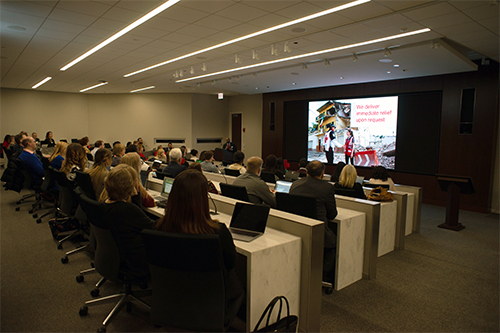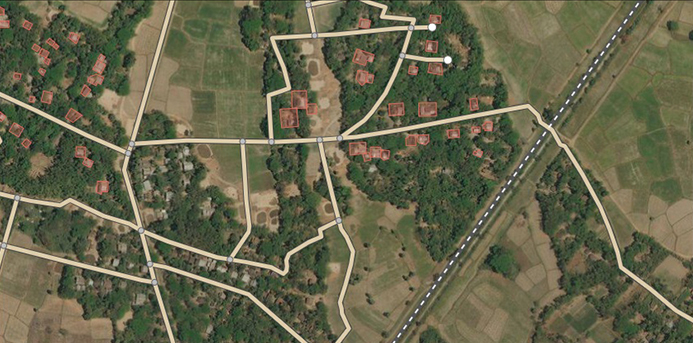What do you do in a crisis when the emergency first responders can’t find you? This is not a question we ask ourselves in the United States. However, in countries like Nepal, Indonesia, the Philippines; in countless regions of Africa, South America, and Asia Pacific, where there are literally millions of uncharted roads, this is a challenge that first responders face all too often.
The Red Cross, a 137-year-old humanitarian organization, in a joint effort with William Blair, a global investment banking boutique, has undertaken to map these myriad roads through a collaborative project called Missing Maps. Since its inception in 2014, the American Red Cross and Red Crescent Societies have engaged some 70,000 volunteers worldwide who together have mapped more than 5 million homes, structures, and buildings.
On Feb. 28, 50 more local volunteers arrived for another Mapathon at the William Blair building in Chicago armed with laptops and a desire to help put some of the world’s most vulnerable inhabitants on the map, literally.
“It’s an interesting global effort to improve disaster response around the world,” says Koby Langley, American Red Cross SVP for International Services and Service to the Armed Forces.

The idea grew out of a direct need of first responders in remote, highly disaster-prone areas of the world to locate those individuals who desperately needed help. Relief organizations and volunteers simply could not get to them in time, or sometimes ever.
“It was literally a realization that … there was no way to navigate to these locations. That there was no infrastructure, no government support, and no roadways in order to get to some of these communities, (many of which) are only accessible by foot,” Langley says.
To date, Missing Maps volunteers have helped save lives following disasters in Nepal, Haiti, Ecuador; during the Ebola virus epidemic in West Africa; and the Tsunami in Indonesia.
Collectively, Missing Maps has integrated all of the Red Cross and Red Crescent movements into the crowd sourcing of individuals to hand-map different at-risk areas of the world. As a result, there are now 191 Red Cross and Red Crescent societies worldwide who are not only creating but also translating these maps into the local languages. Just this year alone, they have mapped more than 800,000 buildings.
“These maps are life-saving instruments (that) allow first responders and humanitarian organizations to bring much needed relief to vulnerable populations in case of a disaster or disease epidemic,” says Celena Roldán, CEO, American Red Cross of Chicago & Northern Illinois. “When you think about what is needed to make sure that you can respond during a disaster, to be able to provide assistance and help as quickly as possible, it is so important to make sure that you have more of the areas of the world mapped.”
During the Mapathon, participants received training on how to use technology to trace roads and add details like buildings in some of the most remote and in-danger areas of the globe.

“The Red Cross has been a phenomenal organization to support and be a part of (particularly) when you see the good work we are doing both locally and around the world,” says Jaime Wildman, managing director, William Blair, and board member, American Red Cross Chicago & Northern Illinois. “When people are at their lowest point in many situations … it’s very moving to see the impact this organization is able to make.”
The American Red Cross of Chicago & Northern Illinois serves 9.5 million individuals throughout 21 counties. The American Red Cross shelters, feeds, and provides emotional support to victims of disasters; supplies approximately 40 percent of the nation’s blood; teaches life-saving skills; provides international humanitarian aid; and supports military members and their families. It leads volunteer activities on 180 locations on military installations, 171 veteran affairs facilities, and provides emergency communication assistance services to more than 80,000 military members and their families annually.
Currently, more than 40 million vulnerable individuals have been put on the world map. The goal is to identify 200 million by 2021.
“Anybody can do this,” Roldán emphasizes. “Young people can do this; all generations. You can do it from your home, you can do it from your office, and you are literally able to help people in a really critical way from wherever you may be.”
More from Make It Better:
- Give Time, Things, Support: 8 Ways to Give Back Around Chicago This Spring
- Better Makers: EISENOPOLY Raises a Record $215,000 for Gastrointestinal Cancer Research
- You Said It: Empowering Teachers to Enhance Their Classroom Experience and Ultimately Their Students’ Lives
 Erstwhile columnist/photographer for the Daily Herald and currently 22nd Century Media, for the past 12 years Lee A. Litas has likewise been a dining and trend columnist and photographer for Pioneer Press, first under the Chicago Sun-Times and now under the Chicago Tribune umbrellas. Hailing from a half-Greek/half-Russian family where “filoxenia” was the way of life, Litas now makes it her business to find the juiciest morsels, both newsy and edible, wherever she travels. Graduate of The American Graduate School of International Management-Thunderbird and Indiana University’s Ernie Pyle School of Journalism; polyglot, all-around gadabout, and Argentine tango dancer — not all at the same time, mostly.
Erstwhile columnist/photographer for the Daily Herald and currently 22nd Century Media, for the past 12 years Lee A. Litas has likewise been a dining and trend columnist and photographer for Pioneer Press, first under the Chicago Sun-Times and now under the Chicago Tribune umbrellas. Hailing from a half-Greek/half-Russian family where “filoxenia” was the way of life, Litas now makes it her business to find the juiciest morsels, both newsy and edible, wherever she travels. Graduate of The American Graduate School of International Management-Thunderbird and Indiana University’s Ernie Pyle School of Journalism; polyglot, all-around gadabout, and Argentine tango dancer — not all at the same time, mostly.

